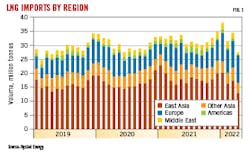Europe accelerating LNG terminal development
Germany, the Netherlands, and the Baltic States are leading an acceleration in development of European LNG import terminals. Increased volatility in the LNG spot market has prompted a return of interest in long-term contracts. The sharp reduction in Russian volumes available for shipment to Europe following the country’s invasion of Ukraine, meanwhile, has led to a surge in cargoes form elsewhere—primarily the US—to meet still strong spot demand.
Before the war in Ukraine, Asia had been the primary destination for US-sourced LNG. Competition between the two regions for supply prompted record-high prices in both. Figs. 1-2 show overall import volumes by region and European import volumes by source, respectively.
The European Commission in March 2022 proposed its REPowerEU plan, designed to reduce consumption of Russian gas by two thirds by end-2022 and eliminate consumption of Russian fossil fuels entirely by 2030. The pressing need for supplies has prompted renewed contemplation of investment in liquefaction capacity after a global total of just four projects were sanctioned 2020-21:
- Sempra Energy’s Energia Costa Azul on Mexico’s Pacific coast (3.25 million tonnes/year (tpy), in-service late 2024).
- QatarGas’s North Field Expansion (49 million tpy, 2027).
- Woodside Petroleum Ltd.’s Pluto LNG Train 2 in Western Australia (5 million tpy, 2026).
- PJSC Gazprom’s Baltic LNG (13 million tpy).
Advancement of the last of these is no longer certain given sanctions imposed on Russia after its invasion of Ukraine. More certain is the progress of LNG receiving terminals in Europe, details of which follow.
Germany
Germany in March 2022 accelerated plans for building two LNG terminals, one in Brunsbuttel (8 billion cu m/year (bmcy)) and one in Wilhelmshaven (7-8 bcmy). German LNG Terminal GMBH—a joint venture of Gasunie LNG Holding BV, Vopak LNG, Oiltanking GMBH, and state bank Kreditanstalt für Wiederaufbau (KfW)—will build the terminal at Brunsbüttel, which will include a jetty with two berths for ships up to Q-Max size (266,000 cu m), distribution infrastructure for trucks, rail tank cars, and smaller ships, and two 165,000-cu m storage tanks.
KfW joined the project via a Mar. 2, 2022, MOU to start construction. German LNG plans to begin operations in early 2023. The project is being designed to import ammonia as well.
Uniper SE in 2021 had said it would repurpose its planned LNG terminal at Wilhelmshaven to hydrogen, under the name Green Wilhelmshaven (OGJ Online, Apr. 19, 2021). The changed natural gas supply dynamics on the European continent, however, have altered these plans and the company has scheduled a 2023 in-service date for the terminal, with Belgian hydrogen company Tree Energy Solutions separately developing the project’s green fuels potential.
Open Grid Europe intends to build a 30-km, 10-bcmy pipeline to connect the terminal both to its network and to storage in Etzel, Germany.
Hanseatic Energy Hub (HEH), meanwhile, is developing a 12-bcmy LNG terminal in Stade, Germany. HEH, a consortium of Fluxys, Partners Group Holding AG, Buss Group GMBH & Co. KG, and Dow Chemical Co., plans to reach a final investment decision (FID) on the project in 2023 and start terminal operations in 2026.
Energie Baden-Wurttemberg AG (EnBW) has agreed to buy 3 bcmy of gas from Stade LNG.
The Netherlands
NV Nederlandse Gasunie in May 2022 agreed to charter a 170,000-cu m, 900-MMscfd FSRU from New Fortress Energy Inc. for 5 years beginning third-quarter 2022, providing additional storage and regasification for the company’s new LNG terminal in Eemshaven, the Netherlands.
New Fortress says the Eems Energy Terminal—featuring the newly chartered vessel working in tandem with Exmar Group’s S188 FSRU—will be able to import 8 bcmy, enough LNG to meet the country’s gas needs without relying on pipeline imports.
Gasunie chartered the 4.5-bcmy S188 in March 2022 for 5 years. The vessel is scheduled to arrive in Eemshaven in early August 2022.
Gasunie plans to build a permanent shore-based terminal, also capable of storing green hydrogen, at Eemshaven in the future.
Gate Terminal BV, a joint venture of NV Nederlandse Gasunie and Royal Vopak, plans to increase its capacity by 1.5 bcmy, reaching a total of 13.5 bcmy by Oct. 1, 2024. The terminal began operations in Maasvlakte, near Rotterdam, during September 2011, with three 180,000-cu m storage tanks and two jetties.
Baltic Sea
Estonian gas system operator Elering AS’s contractor, Connecto AS, has begun building the pipeline that will connect Elering’s planned floating 5-bcmy Paldiski LNG terminal in Estonia to the regional Balticconnector natural gas network.
The pipeline’s route has been marked and site preparation is underway. Directional drilling between the terminal’s compression and the coast was scheduled to begin in July 2022.
Estonia’s use of the FSRU is a temporary measure until a permanent home for it can be built in Finland. Elering and Gasgrid Finland in May 2022 signed a cooperation agreement for the joint lease and management of the FSRU to ensure the security of gas supply to the two countries and to end the need for Russian gas.
According to the cooperation agreement, the parties each will develop the necessary infrastructure for the respective terminals and bear the related costs. But FSRU rental costs are going to be covered jointly in proportion with Estonian and Finnish gas consumption, 20% and 80% respectively.
Front-end engineering and design for the terminal has been completed, with construction and environmental permits also secured.
The FSRU will arrive in Estonia by end-2022 and remain there until work at the Finnish site is completed. Once the FSRU is stationed in Finland, Estonia will have two potential gas supply directions, Balticconnector and the FSRU in the north, and Latvian underground gas storage, Lithuania’s 3.7-bcmy Klaipeda LNG terminal, and the Polish-Lithuanian gas connector in the south. The war in Ukraine has made completion of this latter stage of the project, originally slated for 2024, uncertain.
The 600-MMscfd Skulte LNG terminal will station a floating regasification unit (FRU) 2.5 km offshore Skulte, Latvia. A 5-km subsea pipeline, routed to avoid high-traffic areas, will connect the FRU to shore. The project also will include a 34 km pipeline to the 2.3-bcm Incukalns underground gas storage site and the ability to berth vessels of 40,000-170,000 cu m.
Gas imported through Skulte will supply both Estonia and Finland as well as Latvia. The terminal is expected to enter service by end-2024.
JSC Skulte LNG Terminal owns 80% of the project and JSC Virsi-A, a Latvian fuel trader and energy company, the remaining 20%.
The Balkans
Plans to build an LNG terminal on the Slovenian coast have met with local and environmental resistance. The country instead shifted its focus to, by fourth-quarter 2022, importing natural gas delivered to the 2.6-bcmy LNG Croatia terminal on Krk Island, which started operations in January 2021.
Slovenia’s gas operator, however, failed to win a tender for LNG Croatia’s remaining capacity and has switched its focus to potential imports from GNL Adriatico SRL’s 8-bcmy terminal in Rovigo, Italy. GNL Adriatico is a venture of ExxonMobil Corp., Qatar Petroleum, and Snam SPA.
Hrvatska Elektroprivreda, Croatia’s state-owned gas and electricity utility, is planning a 0.3-bcmy expansion to LNG Croatia, increasing total capacity of the FSRU to 2.9 bcmy with another 0.6-bcmy expansion contemplated in the future. The vast majority of cargoes arriving at Krk have been sourced from the US.
Italy
Italy in March 2022 announced plans to acquire two FSRU with a combined capacity of 10 bcmy as a means of cutting reliance on Russian gas. In May 2022 Snam acquired the 140,000-cu m Golar Arctic LNG carrier which will be converted to an FSRU and stationed in Portovesme, Sardinia, by 2024 (OGJ Online, May 18, 2022).
The following month the company bought the 170,000-cu m Golar Tundra which it expects to be operational off the central Italian coast by second-quarter 2023. The vessel is already equipped to operate as a 5-bcmy FSRU. Snam will purchase it and temporarily lease it back to Golar until shore works for the terminal are completed.
Greece
Gastrade SA began construction in May 2022 of its 5.5-million tpy terminal offshore Alexandroupolis, Greece, targeting an end-2023 in-service date. The terminal will use a 153,500-cu m FSRU, connected to Greece’s National Natural Gas Transmission System by a 28-km, 30-in. OD pipeline.
Regasified LNG will be transmitted to markets in Greece, Bulgaria, and the rest of southeastern Europe, with the prospect of supplying Ukraine as well, according to Gastrade. The Alexandroupolis FSRU has contracted 60% of its capacity.
The company also applied to Greece’s Regulatory Authority for Energy for a new independent natural gas system (INGS) license to develop a second FSRU-based LNG terminal, Thrace INGS, near the first FSRU offshore Alexandroupolis. The planned 170,000-cu m vessel would deliver through the pipeline being built for Alexandroupolis LNG.
Greek utility Mediterranean Gas SA in March 2022 received necessary licensing for its planned 4.6-bcmy Argo LNG terminal in Volos, Greece. The project will use a 150,000-180,000 cu m FSRU with gas supplied by ExxonMobil LNG, according to an MOU reached in October 2021.
France
The French government and TotalEnergies SE in March 2022 began discussions regarding building a 5.3-bcmy FSRU-based terminal in the port of Le Havre. The port had previously hosted an onshore terminal that imported Algerian LNG for Gaz de France.
French gas-system operator GRTgaz SA said the terminal would take about 2 years to implement, depending on its precise location in the port and attendant administrative requirements. Connecting the FSRU to GRTgaz’s network would require construction of a 2-3 km pipeline.
UK
Trafigura Group Pte. Ltd. acquired rights to the 600-MMcfd Teesside GasPort UK terminal—shut since 2015—in 2017 and is contemplating reopening it given current market and political conditions. When operated by Excelerate Energy from 2007 to its closure, the terminal could accommodate vessels as large as 150,900 cu m.

Christopher E. Smith | Editor in Chief
Christopher brings 27 years of experience in a variety of oil and gas industry analysis and reporting roles to his work as Editor-in-Chief, specializing for the last 15 of them in midstream and transportation sectors.

